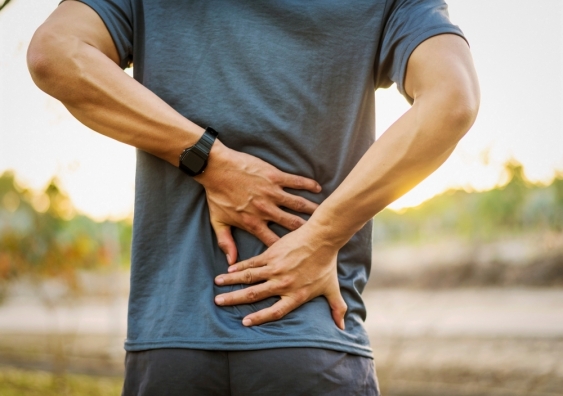Study reveals uncertainty around efficacy and safety of low back pain analgesics
Muscle relaxants might not be as effective at easing back pain as previously thought, a review indicates.
Muscle relaxants might not be as effective at easing back pain as previously thought, a review indicates.

For the last 30 years, low back pain has been the leading cause of disability worldwide. As a major global public health issue, it places a burden on individuals, society and the healthcare system. Low back pain is a common reason for a visit to the doctor, with patients often prescribed analgesics to manage their symptoms.
Muscle relaxants are the third most frequently prescribed drugs for low back pain and are commonly prescribed to reduce the pain, not to cure whatever is causing the pain.
A new study led by researchers at the School of Health Sciences at UNSW Sydney has revealed considerable uncertainty exists around the clinical efficacy and safety of muscle relaxants.
The research revealed although non-benzodiazepine antispasmodics may have reduced pain intensity at two weeks or less for acute low back pain, the effect is unlikely to be considered clinically important.
“We found that muscle relaxants might reduce pain in the short term, but on average the effect is probably too small to be important and most patients wouldn’t be able to feel any difference in their pain compared to talking a placebo, or sugar pill. There is also an increased risk of side effects,” said Professor James McAuley, Director for the Centre for Pain IMPACT at UNSW and a lead author of the study.
“We were surprised by this finding as earlier research suggested that muscle relaxants did reduce pain intensity. But when we included all of the most up to date research, the results became much less certain.”
Side effects of muscle relaxants can include dizziness, drowsiness, headache, and nausea.
As a result of the study, the researchers recommended large, definitive, placebo-controlled trials to urgently resolve uncertainties around the efficacy and safety of muscle relaxants for low back pain.
Clinical practice guidelines reviewed by the research team provided conflicting recommendations for the use of muscle relaxants to treat low back pain. Of the 15 clinical practice guidelines reviewed, six recommended muscle relaxants to manage low back pain, five didn’t recommend them, and four didn’t offer a recommendation.
The researchers noted that although muscle relaxants are typically prescribed for short-term use, the effects of long-term use are not known. They recommended high-quality data are required to evaluate the efficacy and safety of long-term use, which is particularly important when considering the risk of dependency and misuse associated with muscle relaxants has been observed from indirect evidence. Some muscle relaxants, such as carisoprodol, can become habit-forming.
However, the researchers cautioned that firm recommendations around the use of muscle relaxants cannot be provided until larger, definitive controlled trials resolve any uncertainties. They encouraged clinicians to discuss uncertainties in the efficacy and safety of muscle relaxants with their patients, sharing information about the possibility for a worthwhile benefit in pain reduction but increased risk of experiencing a non-serious adverse event. This will allow patients to make informed treatment decisions based on current information until further research is completed.
“We systematically reviewed the evidence to estimate the efficacy, acceptability, and safety of muscle relaxants compared with placebo, usual care, or no treatment in adults with low back pain. Forty-nine trials were included in the review, of which 31 – sampling 6505 participants – were quantitatively analysed,” said Aidan Cashin, a Postdoctoral Research Fellow at UNSW and a lead author of the study.
Eighteen different muscle relaxants were included in the trials investigated, most commonly non-benzodiazepine antispasmodics, antispastics and benzodiazepines. The relaxants were administered orally in 35 trials, by intramuscular injection in 10 trials, and by intravenous injection in one trial.
In three trials the drugs were administered in a mixed manner, by intramuscular injection and subsequent oral doses. Most trials compared a muscle relaxant with placebo.

The relaxants were administered orally in 35 trials, by intramuscular injection in 10 trials, and by intravenous injection in one trial. Photo: Shutterstock
One finding that surprised the researchers was the large number of trials investigating muscle relaxants that were at high risk of bias, reducing the certainty of evidence.
“We were also surprised to see that so much of the research wasn’t done very well, which means that we can’t be very certain in the results. There is a clear need to improve how research is done for low back pain so that we better understand whether medicines can help people or not.
“We found no trials which looked at the long-term effects of muscle relaxants for low back pain. We don’t know if muscle relaxants provide long-term benefits. However, we would assume the pain relief would be the same or more likely even smaller than what was seen for short-term pain reductions,” said Professor McAuley.
Of the 39 completed trials assessed for overall risk of bias, eight were assessed at low risk, three at moderate risk, and 28 at high risk. The most common reasons for being at high risk were from attrition bias (failure to report intention-to-treat effects), performance bias (inadequate blinding of participants) and detection bias (inadequate blinding of outcome assessors).
In order to reduce bias and transparently report results, the researchers recommended future trials should endeavour to adhere to methodological safeguards.
Professor McAuley said there is a clear need to develop and test new effective and cost-effective treatments for people with low back pain.
“Clinical practice guidelines for the management of low back pain recommend that people with recent onset low back pain should be provided with advice and education about the low back pain; they should be reassured that they do not have a serious condition and that their low back pain is very likely to improve over time, whether or not they take medicines or other treatments.
"We know that people with low back pain should avoid staying in bed, and they should try to be active, and continue with usual activities, including work, as much as they can. The best quality research shows that people who do this, are more likely to recover faster and more completely."
The full research paper can be viewed here.